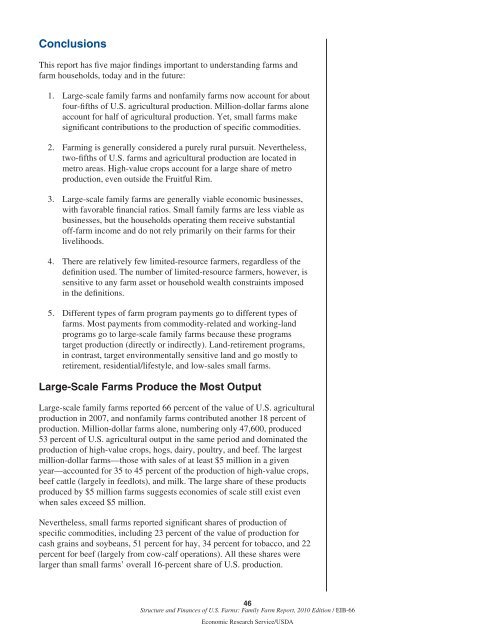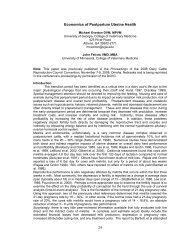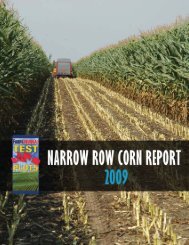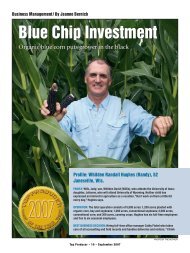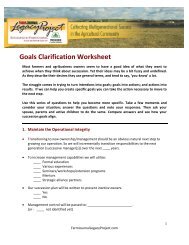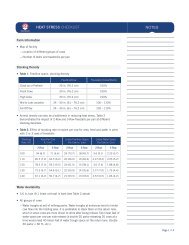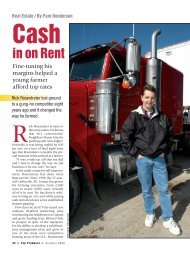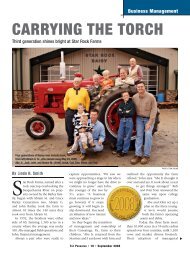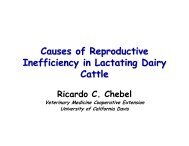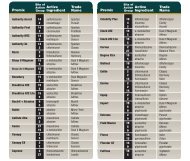Structure and Finances of U.S. Farms: Family Farm Report ... - AgWeb
Structure and Finances of U.S. Farms: Family Farm Report ... - AgWeb
Structure and Finances of U.S. Farms: Family Farm Report ... - AgWeb
Create successful ePaper yourself
Turn your PDF publications into a flip-book with our unique Google optimized e-Paper software.
ConclusionsThis report has five major findings important to underst<strong>and</strong>ing farms <strong>and</strong>farm households, today <strong>and</strong> in the future:1. Large-scale family farms <strong>and</strong> nonfamily farms now account for aboutfour-fifths <strong>of</strong> U.S. agricultural production. Million-dollar farms aloneaccount for half <strong>of</strong> agricultural production. Yet, small farms makesignificant contributions to the production <strong>of</strong> specific commodities.2. <strong>Farm</strong>ing is generally considered a purely rural pursuit. Nevertheless,two-fifths <strong>of</strong> U.S. farms <strong>and</strong> agricultural production are located inmetro areas. High-value crops account for a large share <strong>of</strong> metroproduction, even outside the Fruitful Rim.3. Large-scale family farms are generally viable economic businesses,with favorable financial ratios. Small family farms are less viable asbusinesses, but the households operating them receive substantial<strong>of</strong>f-farm income <strong>and</strong> do not rely primarily on their farms for theirlivelihoods.4. There are relatively few limited-resource farmers, regardless <strong>of</strong> thedefinition used. The number <strong>of</strong> limited-resource farmers, however, issensitive to any farm asset or household wealth constraints imposedin the definitions.5. Different types <strong>of</strong> farm program payments go to different types <strong>of</strong>farms. Most payments from commodity-related <strong>and</strong> working-l<strong>and</strong>programs go to large-scale family farms because these programstarget production (directly or indirectly). L<strong>and</strong>-retirement programs,in contrast, target environmentally sensitive l<strong>and</strong> <strong>and</strong> go mostly toretirement, residential/lifestyle, <strong>and</strong> low-sales small farms.Large-Scale <strong><strong>Farm</strong>s</strong> Produce the Most OutputLarge-scale family farms reported 66 percent <strong>of</strong> the value <strong>of</strong> U.S. agriculturalproduction in 2007, <strong>and</strong> nonfamily farms contributed another 18 percent <strong>of</strong>production. Million-dollar farms alone, numbering only 47,600, produced53 percent <strong>of</strong> U.S. agricultural output in the same period <strong>and</strong> dominated theproduction <strong>of</strong> high-value crops, hogs, dairy, poultry, <strong>and</strong> beef. The largestmillion-dollar farms—those with sales <strong>of</strong> at least $5 million in a givenyear—accounted for 35 to 45 percent <strong>of</strong> the production <strong>of</strong> high-value crops,beef cattle (largely in feedlots), <strong>and</strong> milk. The large share <strong>of</strong> these productsproduced by $5 million farms suggests economies <strong>of</strong> scale still exist evenwhen sales exceed $5 million.Nevertheless, small farms reported significant shares <strong>of</strong> production <strong>of</strong>specific commodities, including 23 percent <strong>of</strong> the value <strong>of</strong> production forcash grains <strong>and</strong> soybeans, 51 percent for hay, 34 percent for tobacco, <strong>and</strong> 22percent for beef (largely from cow-calf operations). All these shares werelarger than small farms’ overall 16-percent share <strong>of</strong> U.S. production.46<strong>Structure</strong> <strong>and</strong> <strong>Finances</strong> <strong>of</strong> U.S. <strong><strong>Farm</strong>s</strong>: <strong>Family</strong> <strong>Farm</strong> <strong>Report</strong>, 2010 Edition / EIB-66Economic Research Service/USDA


